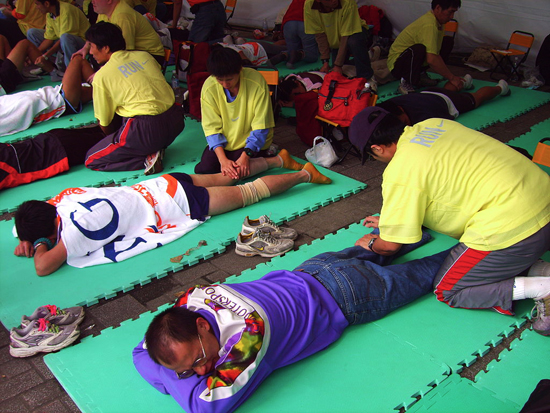Running and Friendly Links
Looking for more great content? Visit our partner sites:
The Green Frugal
I Can Fix Up My Home
Do you need an article written and featured on one of our sites or yours to promote your business? Hire Me!
Tim Noakes’ Ten Laws of Running Injuries, Law Four
Most Injuries are Curable with Medical Treatment


One of the most learned researchers in the field of running and human fitness and performance is Tim Noakes, M.D., of South Africa. His seminal book Lore of Running is one of the classic books in this field.
Obviously, all runners and athletes in general should have a copy on their bookshelves. One topic Noakes outlines is what he calls the Ten Laws of Running Injuries. Let’s examine the fourth law.
Law Number 4 – Most Injuries are Curable
Well, this is about the best news we can hope to hear as runners! Even better, the effectiveness of both medical and holistic treatments keeps getting better and better all the time.
In this law, Dr. Noakes points out that the techniques used to treat most running injuries are simple (read inexpensive) in nature and surgery is rarely required although an overly-zealous M.D. not well-versed with running might try to convince you otherwise.
Dr. Noakes conducted a study for eight weeks at his clinic of 200 consecutive running injuries. The results were impressive; following the therapy techniques described Lore of Running, 4th Edition, three quarters of the runners were pain-free and had regained their mileage base. Most of the others had slacked off on their therapy.
Types of Injuries that are Difficult to Cure
Now for the bad news. There are injuries that defy treatment. Three categories are identified here.
- Athletes that have severe biomechanical abnormalities that are beyond correction by conventional means. For example, prescription orthotics can compensate for a vast range of issues but there are cases that are beyond the scope of their help. Reduced mileage may be an option.
- Degeneration of key tissues used in running. Dr. Noakes points out that the Achilles tendon is especially at risk. It is important to note that we are talking about physical degeneration (tendinosis) and not simple inflammation (tendinitis).
While it is true that degenerative conditions can be cured to some extent, recurrence is quite probable. Sorry.
- The third type is characterized by people who take up running with joints are already abnormal due to earlier injuries and subsequent surgeries. Typically these earlier injuries have been sustained in sports like football, rugby, or hockey.
The real culprit in this situation is the major surgery involved. Regardless of how well it went, the joint will never be 100%. While this likely does not pose a problem in day-to-day living, the stress and impact of running is too much.
Types of Therapy for Running Injuries
There are many types of treatment that may bring relief. It is too early to say, but the more Obamacare is rolled out, the more difficult it is getting conventional treatment for recreational activities. Here are some other considerations:
- Massage. This ancient treatment involves manipulating muscles, ligaments, and connective tissues. Massage can be proactive; that is, if you can afford it, a weekly sports massage will prevent injuries. After suffering one this is a great way to work out the toxins and speed recovery.
- Acupuncture. This is simply inserting needles into designated point on the body to alleviate pain an inflammation.
- Acupressure. This is much the same as acupuncture but simply involves applying pressure at the points with the fingertips. One benefit is that the runner can apply his or her own therapy on the fly.
- R.I.C.E. This one is time-tested and is an acronym for Rest, Ice, Compression, Elevation. Any number of people have their own ice solution; I prefer bags of frozen peas since their shape allows close molding and refreezing is easy and quick.
If First You Fail, Try, Try Again
Dr. Noakes rounds out this law by stating that your first attempt at finding a fix might not be successful. If this is the case, do not despair; the human body is very complex and each one is unique. Even General Motors is overwhelmed with recalls for poorly-engineered components and those vehicles are standardized!
Instead, seek out help elsewhere. The key concept to take away is that it is important to focus on experts that understand running. Not every doctor falls in this category despite how many diplomas are hanging on the wall.
Check back; we will be posting the other laws soon! In the meantime, here are the ones we have posted:
- Tim Noakes’ Ten Laws of Running Injuries; Law One
- Tim Noakes’ Ten Laws of Running Injuries; Law Two
- Tim Noakes’ Ten Laws of Running Injuries; Law Three
- Tim Noakes’ Ten Laws of Running Injuries; Law Four
References:
- Tim Noakes, MD (1985). Lore of Running, Fourth Edition. South Africa: Oxford University Press
Website © 2011 KSmith Media, LLC; all rights reserved; content may not be copied, rewritten, or republished without written permission. Webmaster’s Google profile
Recommended Running Injury Articles
- Stress Fracture or Shin Splints?
- Specific Stretches Offer Relief for Runner’s Knee
- Curing Plantar Fasciitis
- How to Stop or Prevent a Side Stitch
Website © 2011 KSmith Media, LLC; all rights reserved. Webmaster’s Google profile











